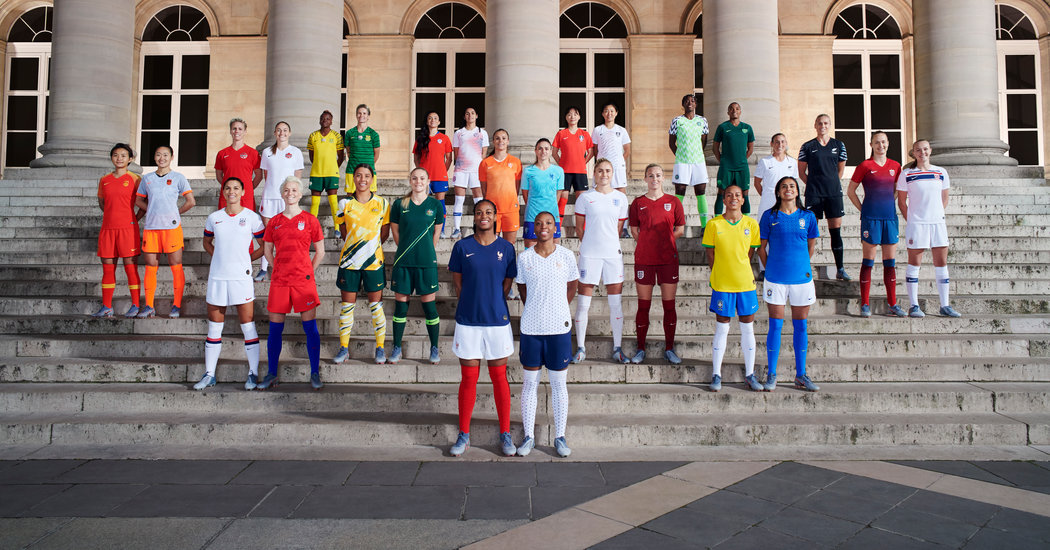
The United States women’s soccer team has been fighting for gender parity not just in the courts — suing the United States Soccer Federation last week for discrimination — but also in their uniforms, known as kits. And at least when it comes to the clothes and the Women’s World Cup, they have won.
On Monday, at a global event in Paris, Nike revealed the new home and away uniforms for 14 out of 24 competing teams, and for the first time since the brand began working with the WWC tournament in 1995, each one of them was made specifically for the women’s teams, not as derivations or extensions of kits made for men. Three days before, to coincide with International Women’s Day, Adidas released its new designs for four WWC teams.
In the larger picture of gender issues and sports, this may not seem like a big deal. But the clothes athletes wear speak loudly about identity and allegiance, and have the power to help instill confidence. Clothes are also the easiest way for fans to assert their own allegiance, aspiration and personal connection. They are, above all, symbols. And now they are finally symbols of parity.
“We are shifting more resources to women,” said Amy Montagne, the vice president for global categories at Nike — and not just because this is the largest number of teams the company has worked with. (It outfitted 11 clubs for the 2015 Women’s World Cup.) But because, Mark Parker, the chief executive, said, “We believe this summer can be another turning point for the growth of women’s football.”
Certainly, given Nike’s current emphasis on women’s sports — the Dream Crazier campaign, a series of new initiatives designed to support women’s coaching and engage more girls — as well as its own experience with Serena Williams and the current focus on female dress in the competitive arena, it would have been fairly hypocritical for the company to treat its women’s soccer kit as in any way secondary to men’s. (Especially given Nike’s own somewhat uncomfortable internal history with gender issues.)
Yet it wasn’t until 2015 that Nike began making women’s soccer jerseys in men’s sizes so that more male fans could buy them. And it wasn’t until the players really spoke up that things began to change.
“Three years ago they said, ‘We want our own thing,’” Cassie Looker, the senior apparel product manager for global football, said in a call from France. “Their own thing” refers to both fit and to the design of the uniforms, which Nike refers to as the “storytelling.”
According to Ms. Looker, the fit took three years and multiple four-dimensional body mapping sessions of professional athletes to adjust. “They are shaped differently than the standard body type,” she said. “They generate most of their power from their lower body.”
While male soccer players like a slimmer fit — “It makes them feel more powerful, like superheroes,” Ms. Looker said — women are more interested in comfort and “looking professional.” This meant a lot of focus on the length of the sleeve (the athletes did not want to expose too much of their upper arms) and the neckline, which ended up halfway between a V-neck and a crew neck, with enough give to be easily pulled over a ponytail.
“They want zero distractions,” she said.
Most of this may be lost on the armchair soccer fan, though the storytelling implicit in the design will not. (In any case, the kits are available in two fits: athlete and “stadium,” or looser, for the weekend fan.) Though the kits rely on the color palettes of national flags, the difference is often in the pixelated details.
“Chile, France, U.S.A. — they are all red, white and blue,” Ms. Looker said, which can make them hard to distinguish. “We bring it up all the time internally.”
What to expect? The United States jerseys have a throwback patriotism with (in the home kit) direct references to the jerseys worn by the 1999 team that transformed the profile of women’s soccer in America: white, with red and blue stripes on the sleeves.
The names of the 50 states are printed in gray on the back, and three stars over the crest nod to the three championships the United States has won. The away kit has tonal abstractions of stars and stripes on red (though they read a little blotchy from afar).
Also tonal are the roses and assorted other florals on the four burgundy-red quadrants of the England jerseys, which is why France’s hexagonal blue polka dots on white stand out, as does the Norwegian snowflake pattern that fades from red to blue, giving their home jersey an Empire-waist effect and uniting the shorts and top.
By athlete request Chile, Nigeria, South Africa and Korea have the same pattern that the men’s teams wore in the 2018 World Cup, though the fit has been customized for the women. (At least in Nigeria’s case, the look was so successful that you can kind of understand why they didn’t want to mess with a good thing.)
And then there’s Australia. Of all 14 Nike team looks, this will likely be the most controversial; a canvas of forest green, mustardy gold and white slashes and splotches that looks sort of like animal print meets modern art landscape painting.
Together with the Sweden kit, by Adidas, which features the faces of female role models chosen by the players embedded in the numbers on the back of each jersey, it makes a statement that, on the pitch or the street, will be impossible to miss.







